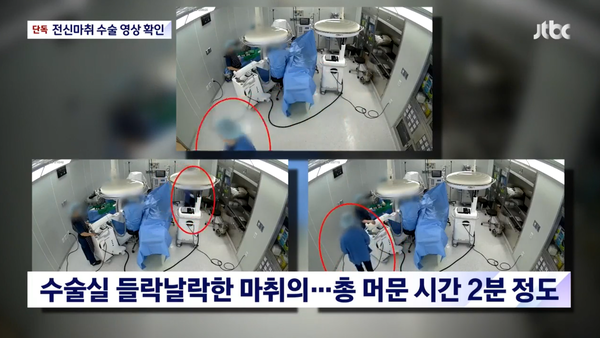After the death of a 4-year-old girl undergoing fracture surgery was reported, the general public blamed the anesthesiologist for neglecting patient monitoring in the operating room (OR).
The footage of the surveillance camera in the OR, which was released through the Korean media Wednesday, showed that the anesthesiologist did not stay in the OR but went in and out of the room.
In November last year, the 4-year-old girl underwent surgery for a broken elbow at an orthopedic clinic in Gimpo, Gyeonggi Province. The surgery lasted about 12 minutes but the girl did not wake up. JTBC, the local TV broadcaster, obtained CCTV footage from the OR and released it to the general public. The footage highlighted the anesthesiologist going in and out of the room. The news report pointed out that the anesthesiologist, who was supposed to be "closely monitoring" the operation, did not pay attention.

However, doctors said the shortage of anesthesiologists was to blame for the girl’s death.
It is rare in Korea for an anesthesiologist to be present for the entire surgery in OR because they have to be in charge of two or three ORs simultaneously.
When an anesthesiologist is unavailable, nurses including nurse anesthetists usually back up.
"If you put one anesthesiologist in each OR and have them stay there until the end of the surgery, it would be impossible to operate in Korea," said a professor of anesthesiology and pain medicine at a university hospital. "We have more than 30 operating rooms in our hospital alone, and they are often open simultaneously. That means we need more than 30 anesthesiologists, which we don't have," he said.
Usually, one anesthesiologist is in charge of two or three ORs, and there is a nurse in each room to monitor the anesthesia, he said.
"If you don't understand this reality, there will be even more chaos after the mandatory installation of CCTV in ORs."
The reason why anesthesiologists are becoming increasingly scarce, even though anesthesiology and pain medicine is a "hot" specialty that attracts many applicants, is that fewer doctors stay in the OR after qualifying as a specialist.
Many doctors choose pain medicine over anesthesia.
Anesthesia in pediatrics and childbirth is particularly shunned due to high risks.
"Hospitals need to hire enough staff so that anesthesiologists can be present from the beginning to the end of the surgery," said Yeon Jun-Heum, president of the Korean Society of Anesthesiologists (KSA). "If there is an emergency surgery and they have to leave, another medical professional, such as a nurse, should monitor them."
The anesthesiologists’ group pointed out that the number of anesthesiologists practicing anesthesia needs to be increased through improved reimbursement. According to the KSA, Japan and the United States have 1.2 and 1.6 times the gross national income (GNI) of Korea, respectively, but the reimbursement of anesthesia is 7 and 23 times higher, respectively.
Therefore, it is necessary to calculate anesthesia fees separately and add anesthesia fees for specialists in anesthesiology and pain medicine.
The society is also emphasizing quality management by implementing the “anesthesia real-name system,” establishing the “Korean Anesthesia Safety Standards,” and promoting certification evaluation for medical institutions at the clinic level.

